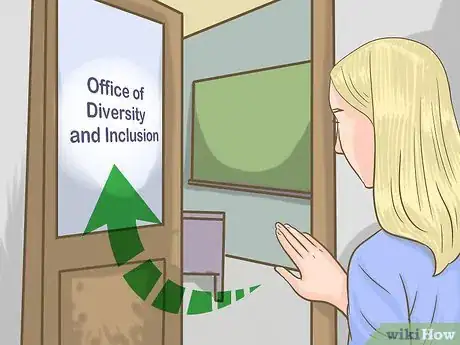This article was co-authored by Joseph Harwood. Joseph (JoJo) Harwood is a Beauty, DEI & Social Media Expert, Artist, CEO of Joseph Hartwood Ltd, and Creative Director of Team Baron Group. With over 15 years of experience, they specialize in all aspects of beauty, digital media production, and supporting diversity and inclusion efforts in businesses. JoJo has pioneered YouTube content and branding, with over 100 million views on their YouTube tutorial content and was the first and only winner of Simon Cowell's You Generation Competition. They studied an MSc in Cosmetic Science from the London College of Fashion, combining a technical understanding of cosmetics with beauty expertise.
There are 12 references cited in this article, which can be found at the bottom of the page.
This article has been viewed 67,359 times.
Promoting diversity, equality, and inclusion in your community can be a big task, but you can find ways to make a difference! To call attention to these values, reach out to your local leaders, use social media, and act as a role model for your peers. At your school, join or start organizations that can host events and speakers. In the workplace, training workshops and inclusive hiring practices can create more diverse and equitable spaces. By spreading the word about these ideals, you can help create a safe, friendly community for all.
Steps
Promoting Your Values Effectively
-
1Act as a role model for your peers. Sometimes, the most effective thing you can do is model inclusive language and actions for others. Put your values into practice, and help your peers understand what it means to treat others with dignity and respect.[1]
- Use the language preferred by individual communities. For example, "autistic people" instead of "people with autism" is the preferred language of the Autistic community. However, everyone has their own language preferences and beliefs. If an autistic person wants to be referred to as a “person who has autism,” use this language to refer to them.
- Respect other people’s chosen pronouns, names, or identities. If someone prefers to be called “he,” “she,” “they,” or something else, respect their wishes instead of trying to correct them.
- Challenge yourself and your friends to have lunch or start conversations with people of ethnicities, faiths, social groups, and identities other than your own.
-
2Involve the leaders of your community, school, or workplace. Any programs you organize to promote your ideals will be most effective if you tap the resources of whoever’s in charge. A school principal, supervisor at work, or local government representative can broaden your impact and help you correct any specific injustices you’ve observed.[2]
- You could write in a letter or email, “I’ve noticed fellow students, faculty, and staff have good intentions, but don't know how to foster an inclusive atmosphere. Our community would benefit from a mentor, and I’d like to seek the administration’s support in hosting educational programs.”
- Reaching out to those in power can be intimidating. However, remember that principals are responsible for your well-being, bosses need to be stewards of companies, and your elected officials work for you.
Advertisement -
3Focus your effort on specific issues so your message doesn’t get lost. Instead of taking on all social issues at once, tackle 1 issue that directly affects your community. Raise awareness of the problem through social media, public events, and 1-on-1 conversations.[3]
- For example, you might notice that sidewalks in your town are poorly maintained, which poses a hazard for people who may have mobility issues. Contact your city councilor, write to your local newspaper, or reach out to your local public works department to correct the issue.
- You might run a public fundraiser to donate books or clothing for children in need. You can also ask volunteers to offer free tutoring for these children.
- In areas with unequal access to healthcare, you could ask local doctors if they would be willing to offer their services for free for people with no health insurance.
-
4Tailor your approach to your audience to make a meaningful impact. Sometimes, people have a hard time getting out of their comfort zone. For friends or relatives who are confused by or resistant to your ideals, try to correct them in a positive way. Since a long lecture might go in 1 ear and out the other, try to keep your response brief and matter-of-fact.[4]
- For instance, if someone makes an offensive comment, you might say, “I understand you have a right to your opinion, but try to see things from a broader perspective. That joke might seem funny to you, but you wouldn’t be laughing if you were on the receiving end.”
Raising Awareness in Your Community
-
1Organize cultural events to expose people to different lifestyles. Fairs, festivals, and other events can help your community learn about other cultures, lifestyles, and beliefs. If planning your own event isn’t possible, you could bring your friends or family to one to help them learn more about your values. Great ways to engage other cultures and lifestyles include:[5]
- International food festival
- International film screenings
- Pride parade
- Lectures and speeches from civil rights leaders
- Ceremonies and celebrations for different religious traditions
- Documentary screenings on important social issues
- Fundraisers for non-profits supporting diversity, equality, and inclusion initiatives
-
2Host a town hall where community members can voice their issues. Making sure that everyone’s voice is heard is an important part of inclusion. Try asking your local elected representative to host an open town hall for the community. For the greatest impact, choose a specific issue that affects your community, such as lack of healthcare or racial injustice in housing development.[6]
- Invite community members to sign up for speaking slots at the beginning of the event. Give each person a certain amount of time to make sure that every person has a chance to be heard.
- Be sure to invite local government figures and policy makers at the event, such as the mayor, town council members, school board members, and chief of police.
- If your local government will not host an open town hall, hold your own. Book a room in a local library, community center, or school to host the event. Promote it on social media, by going to door to door, and by posting fliers at nearby businesses.
-
3Create a fundraising campaign for a charitable cause. Many charitable organizations offer resources for planning fundraisers on their website’s “Get Involved” or “Take Action" section. To host an event at your home or office, offer light refreshments, make quick informative remarks, provide guests with educational pamphlets or fliers, and request donations for your cause.[7]
- You could also host a voter registration drive and inform your peers about the importance of diversity among elected officials.
- Collaborate with other charities and brands to create more awareness.
-
4Start a blog or social media account to spread awareness. A blog on a website like Wordpress, Blogger, or Tumblr can help you raise awareness for your ideals. If you don’t have time to publish your own blog, share articles, opinions, and thoughts through Facebook, Twitter, or your preferred social media site. You may also create multiple blogs and accounts on multiple platforms.[8]
- Use hashtags and keywords that help connect your thoughts to the wider discussion. For example, you might use hashtags like #equalpay, #achievementgap, and #whyIstayed or #whyIleft.
Encouraging Inclusion at Your School
-
1Join or start a social justice club. See if there’s a multicultural association, LGBTQ support network, volunteer group, or related organization at your school. If there isn’t an organization at your school or university start your own! Talk to a teacher, your school’s administration, or the office of student activities to learn your school's specific procedures for starting a club.[9]
- Your club could host speaking events and other educational programming, collect donations, and campaign for specific issues related to diversity, equality, and inclusion. For instance, you could invite a local elected official to offer her take on the importance of women in politics.
-
2Host events that offer opportunities to engage other cultures. Help organize free events for your school community that are both fun and informative. Coordinate with various clubs or organizations to build bridges between interests, activities, and academic subjects. For instance, team up with the language department, LGBTQ center, and writing lab to host a gender neutral writing workshop. Other great event ideas include:[10]
- Cultural fair: celebrate holidays from different religions, hold a food festival with cuisine around the world, or showcase various forms of dance.
- Open mic nights: invite students from a wide range of backgrounds to tell stories, sing songs, or recite poetry about their unique experiences.
- Public lectures: ask scholars, civil rights leaders, and community leaders to talk about how others can help promote this cause.
- Networking events for marginalized groups: ask business leaders and teachers to meet with students. Students can workshop their resumes or find internships through this network.
-
3Volunteer at your school or university’s office of diversity and inclusion. Your school might have an administrative office dedicated to promoting diversity, equality, and inclusion within your community. If your school doesn’t have a diversity and inclusion office, look for opportunities to volunteer with its women’s center, LGBTQ center, student accessibility services, student health, or counseling and psychological services.
- Ask if you can volunteer at an event or help out in the office. At colleges and universities, some offices may even have work study gigs for students.
-
4Encourage friends to take sensitivity training.[11] Search online for a nearby charitable organization or local chapter of a national non-profit related to your values. They can put you in touch with an expert who could offer training programs at your school. Programming ideas include:
- HAVEN Training for helping people who have experienced sexual assault.
- Safe Zone Training for supporting LGBT students.
- Green Zone Training to help military veterans transition into academic life.
- Disability awareness training to provide helpful assistance and access for students with disabilities.
-
5Create safe spaces on your campus. A safe space allows students to discuss their experiences without judgment or criticism. You could create a general safe space for students or make specific spaces for students struggling with their sexuality, sexual harassment, racism, or mental health issues.[12]
- Get help coordinating safe spaces from your school's diversity and inclusion office, women’s center, counseling office, or from teachers who share your ideals. Work with faculty and staff to find and book a suitable location, develop warm-up exercises or ice breakers, and advertise meetings.
- You could book a room through your school's administration and invite students facing specific challenges to talk about their experiences. It's helpful to have a teacher or counselor to moderate the discussion.
- Remind allies that the safe space is a place for others to express their challenges. They may not be looking for advice or sympathy. Ask allies to listen, not to talk.
Promoting an Equitable and Diverse Workplace
-
1Ask HR to give a cultural sensitivity training workshop. For your next seminar, training session, or networking event, why not cover inclusion and diversity? These workshops can focus on a variety of issues, such as sexual harassment, cultural diversity, mental health, or equal access.[13]
- Your HR department can run this themselves by using exercises, courses, and pamphlets found on the internet. They can also hire an outside consulting firm to run the session for them.
- If your business is small or doesn’t have an HR department, talk to your boss. Emphasize how cultural training can strengthen your organization as a whole.
-
2Encourage inclusive hiring practices. Diversity and inclusion begins during the hiring process. Encouraging a more diverse pool of applicants will make your workplace a more inclusive place. Some ways you create an inclusive hiring process include:[14]
- Write job advertisements with broad qualifications to allow a more diverse set of applicants. Be conscious of how your language might imply gender.
- Avoid gendered language in your job advertisement. Instead of using “he” or “she,” say “the applicant” or “they.”
- Advertise your diversity and inclusion policies, including any non-discrimination rules, in your job advertisement. Emphasize that you do not discriminate based on gender, race, religion, ethnicity, or disability.
- Make sure that the interviewers represent a diverse sample from your workplace. Ask broad, open-ended questions. Avoid questions about the applicant’s personal life, such as their religion, marital or relationship status, or children.
-
3Institute policies regarding equal access and discrimination. A set of rules regarding discrimination and equality are important to make sure that everyone knows how they are expected to act. Talk to your boss, human resources (HR), or coworkers about instituting new inclusive policies.[15]
- Establish a no discrimination policy in the workplace. Remind employees that no one can be discriminated against for their race, gender, religion, ethnicity, or sexual orientation. Post this policy in a public place, such as a break room or near the printers.
- Make sure that all employees know how to report discrimination in the workplace. Employees who violate the policy may require sensitivity training or disciplinary action.
- If your company provides health insurance, make sure that it includes policies for a wide range of conditions. Inclusive policies are ones that offer birth control, STD testing, and a wide range of medical conditions.
-
4Explain the importance of a diverse, inclusive workplace. Some people may resist new policies for inclusion or diversity in the workplace. When raising awareness of this issue, remind employees and employers of the benefits of a diverse and inclusive workplace.[16]
- Benefits of diversity and inclusion in the workplace include higher productivity, higher employee satisfaction, and happier customers.
- You might say, "I think it is important to have more diversity in our office. It's been shown that diverse workplaces are more efficient, and their employees are happier."
Community Q&A
-
QuestionCan I ally with a white cis male for safe spaces?
 Luna RoseTop AnswererMy dad is a white cis man, and he's been one of my biggest champions in everything I do. When it comes to working together, it isn't his identity that counts, but his choices and his behavior. If your friend is a trustworthy guy who makes an effort to be a good listener and ally, then go right ahead. It's also possible that he has one or more marginalized identities of his own (like disability, sexual orientation, religion, income, etc.) that he could benefit from a safe space for as well. Whether he directly benefits from it or not, if his heart is in the right place, then he can be a great helper.
Luna RoseTop AnswererMy dad is a white cis man, and he's been one of my biggest champions in everything I do. When it comes to working together, it isn't his identity that counts, but his choices and his behavior. If your friend is a trustworthy guy who makes an effort to be a good listener and ally, then go right ahead. It's also possible that he has one or more marginalized identities of his own (like disability, sexual orientation, religion, income, etc.) that he could benefit from a safe space for as well. Whether he directly benefits from it or not, if his heart is in the right place, then he can be a great helper. -
QuestionCan I get involved by volunteering?
 Ann WilsonCommunity AnswerOf course! Helping out non-profits that advocate for causes that you're passionate about is always a great way to make a difference.
Ann WilsonCommunity AnswerOf course! Helping out non-profits that advocate for causes that you're passionate about is always a great way to make a difference. -
QuestionI hurt my girlfriend two days back. Now she just wants to be friends. As a friend, how should I get her back?
 Luna RoseTop AnswererFriends respect each other's wishes. If your girlfriend doesn't want to date you, don't push her. Give it time to let her cool off. After awhile, give a very brief but heartfelt apology for hurting her, and assure her that you'll respect her boundaries, including her decision to just be friends. Then be a good friend to her, or let the two of you drift apart. If she changes her mind, she'll say she'd like to try again. Otherwise, it may be time to look for a new girlfriend. There's no way to make her want you, so the best you can do is respect her wishes and keep being the best person you can be.
Luna RoseTop AnswererFriends respect each other's wishes. If your girlfriend doesn't want to date you, don't push her. Give it time to let her cool off. After awhile, give a very brief but heartfelt apology for hurting her, and assure her that you'll respect her boundaries, including her decision to just be friends. Then be a good friend to her, or let the two of you drift apart. If she changes her mind, she'll say she'd like to try again. Otherwise, it may be time to look for a new girlfriend. There's no way to make her want you, so the best you can do is respect her wishes and keep being the best person you can be.
Warnings
- Avoid supporting organizations that exclude the people they claim to be helping, such as Autism Speaks. Some groups further exploit marginalized people instead of helping them, so research a charity before you support it.⧼thumbs_response⧽
References
- ↑ https://www.entrepreneur.com/article/281729
- ↑ https://www.forbes.com/sites/forbescommunicationscouncil/2019/09/26/the-importance-of-diverse-role-models/?sh=13bfc2a2582d
- ↑ http://www.un.org/esa/socdev/egms/docs/2009/Ghana/inclusive-society.pdf
- ↑ https://www.splcenter.org/20150125/speak-responding-everyday-bigotry#casual
- ↑ https://www.forbes.com/sites/forbescommunicationscouncil/2019/09/26/the-importance-of-diverse-role-models/?sh=13bfc2a2582d
- ↑ http://www.un.org/esa/socdev/egms/docs/2009/Ghana/inclusive-society.pdf
- ↑ https://www.aclu.org/how-you-can-help
- ↑ https://www.edutopia.org/blog/social-justice-projects-in-classroom-michael-hernandez
- ↑ https://www.learningforjustice.org/professional-development/starting-an-activist-club-at-school
- ↑ https://www.learningforjustice.org/professional-development/starting-an-activist-club-at-school
- ↑ https://cviog.uga.edu/training-and-education/leadership-development/cultural-diversity-sensitivity-training.html
- ↑ https://www.edutopia.org/article/cultivating-classroom-safe-space/
- ↑ https://www.shrm.org/hr-today/news/hr-magazine/pages/010215-cross-cultural-training.aspx
- ↑ https://cdn.americanprogress.org/wp-content/uploads/issues/2012/03/pdf/lgbt_biz_discrimination.pdf
- ↑ https://cdn.americanprogress.org/wp-content/uploads/issues/2012/03/pdf/lgbt_biz_discrimination.pdf
- ↑ https://independentsector.org/resource/why-diversity-equity-and-inclusion-matter/












































































